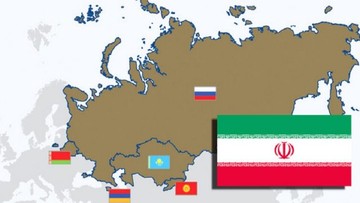“Signing of the partial agreement about free trade between Iran and the Eurasian Economic Union (EAEU) shows the fact that Iranian economy has entered a new level of regional economic cooperation,” Davood Mirzakhani, Assistant Iranian Energy Minister in Iran-Russia Joint Cooperation Commission said on Monday.
“The deal has paved the way for a connection between Iran’s economy with the region,” he added.
Mirzakhani noted that Union’s annual Gross Domestic Product (GDP) surpasses four trillion dollars.
Russia, the block's head, Belarus, Kazakhstan, Armenia and Kyrgyzstan are the five members of the Eurasian Economic Union, an area as big as 20 million square kilometers home to 180 million people.
The official, who was former Iranian economic attaché in Moscow, said that Russia imported more than 250 billion dollars worth of industrial, agricultural products as well as medicine and medical equipment over the past years.
“It could rise up to 300 billion dollars in coming years,” he said.
The Eurasian Economic Union voted last May in favor of the creation of a free trade zone with Iran for a period of three years. Russian President Vladimir Putin, as the bloc’s head, ratified the decision last November. Iran is the second country after Vietnam to create a free trade zone with the regional union.
Mirzakhani described the deal and strengthening of Iran’s relations with the five-member union “important”, saying the country “can be an adequate route for transiting the Union member’s goods through the International North-South Transport Corridor (INSTC).
The multimodal land, rail and sea route starts in Indian port of Mumbai, passes through Iran heading for Europe. The recently-inaugurated Qazvin-Rasht railway nearly completes the INSTC. The last missing link is a railroad that goes from the northern Iranian city of Rasht to Astara on the Republic of Azerbaijan's border.
“Iran enjoys rich oil and gas and mineral resources and is a capable country in terms of technical and construction expertise. All these elements that bring about stability combined with a regional economic centre will turn the country into a marvelous partner for Eurasia”, Mirzakhani said.
He stressed that should Iran finally join the Union, it will be a positive step and can play an effective role in protecting Iran’s economy especially under the new US sanctions.
The senior Iranian energy authority mentioned that joining the Eurasian Economic Union “can be a small-scale and pilot model of joining the World Trade Organization (WTO).” He added such a situation can help Iranian products become more competitive in bigger markets.
'The Eurasian Economic Union Free Trade Zone with Iran is Iran’s first serious step in joining larger trade organizations,” he reiterated, calling it “the most important and practical step against the US policy of isolating the country.”
The Union’s imports from Iran in the past two years amounted to 493.5 million dollars that is 0.20 percent of its total 237 billion-dollar worth of imported goods from the world, according to Mirzakhani.
At the same time, Iran’s imports from the Union member states stood at 2.1 billion dollars, a meager 0.57 percent of 366 billion dollars worth of its exports, he noted.
The Iranian government presented a bill to the parliament on joining the Eurasian Economic Union. Last week, parliamentary National Security and Foreign Policy as well as Economic commissions approved the bill, meaning it can now be debated publicly by all the lawmakers.
The free trade zone treaty can also come to the aid of Iranian producers to export to Europe using preferential trade agreements that some of the Union’s member states such as Kyrgyzstan have with the European Union.

Iran-Eurasia Economic Union Free Trade Zone has taken Tehran to a new level of regional economic cooperation and links Iranian economy with other states, a senior Iranian energy official says.
News ID 190091


Your Comment